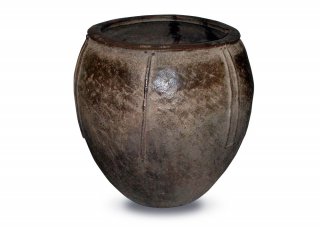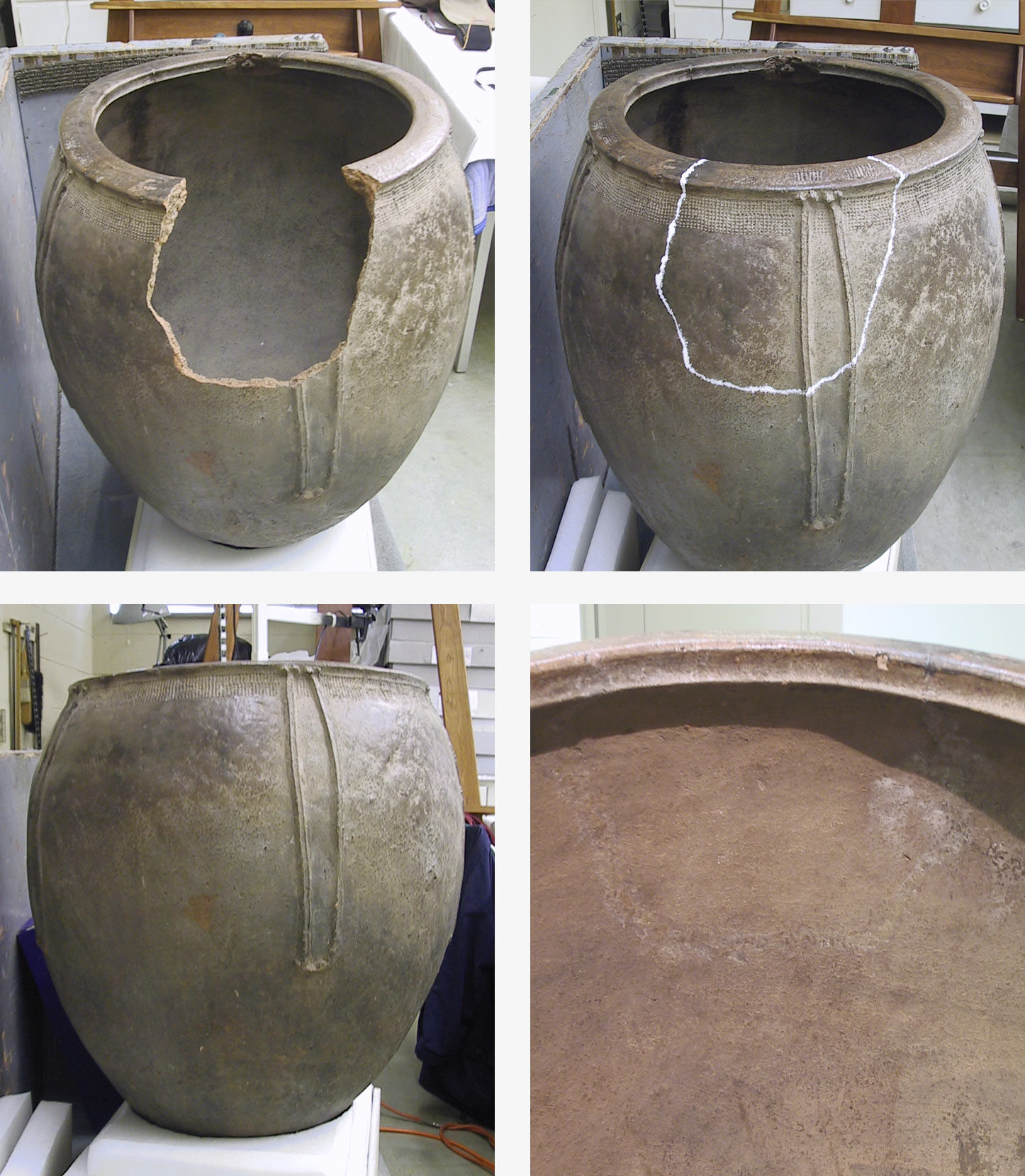
Senufo People
Storage Vessel
West African Earthenware 30 x 26 ¾ x 27 1/8 inches Gift of Dianne Komminsk 2001.8 1101
An Empty Vessel?
Although today it no longer holds any grain, beer, or water, this earthenware vessel does contain multiple histories. Like numerous objects from colonized peoples found in modern museums, some of its history has been lost—we may never know who specifically made it, nor when it was crafted. However, another of this vessel’s stories, that of the West and its changing attitudes toward African art, is better known.
A Day in the Life
Artists and Farmers United
Who are the Senufo people and how do artists operate in their society? Listen to the following audio clip to find out, narrated by Sharon Howard from the Dayton chapter of The Links, Inc.—a professional organization of women dedicated to enriching the cultural life of African Americans and other persons of African ancestry.
Transcript
The Senufo occupy the region of the northern Cote d’Ivoire, southern Mali, and western Burkina Faso. Dubbed “Senufo” by the colonial French, they speak various Gur languages and are comprised of agriculturalist and artisan subgroups. Artisans are minorities within Senufo villages, living in residential quarters as guests on the farmers’ land and exchanging their goods for food; traditionally they are thought to possess great supernatural powers.
Within the artisan subgroups labor is divided. Pottery is a woman’s trade, while male artisans might be weavers or brass casters. The most prolific Senufo art objects found in museums are the idols, masks, and crowns crafted by men for ritual associations and initiation societies, despite the fact that women’s art is also a significant feature of life among the Senufo. Storage vessels, cooking pots, and ritual medicine pots are just a few items crafted by most subgroups, though each group specializes in different vessel forms, and families might have different styles of decoration. The introduction of metal and ceramic pots into the market has resulted in the retirement of some vessels; however, villagers continue to steadily purchase large pots like this one.
Further reading: To learn about the problems associated with Senufo classification in art history, see Susan Gagliardi, Senufo Unbound: Dynamics of Art and Identity in West Africa (Cleveland: The Cleveland Museum of Art, 2014).

Mark Dingemanse, Senufo Languages (artwork published under the Creative Commons Attribution 2.5 Generic license).
Tools and Techniques
Producing the Perfect Pot


Coiling Pot and Bringing Pots to Firing, Katilai, Cote d’Ivoire, 1982 (photographs by Carol Spindel; photographs provided by Carol Spindel).
Senufo potters pass down their skills generationally, modifying their techniques over time. Although we are unsure precisely how this vessel was crafted, looking at how a recent group of Senufo artisans produced their pots can give us a general idea. In 1982, the travel writer and University of Illinois lecturer Carol Spindel traveled to Katilai, Cote d’Ivoire and documented the methods of the Kpeenbele potters. Can you place the steps she observed in the correct order?
Further reading: Carol Spindel, “Kpeenbele Senufo Potters,” African Arts Vol. 22, No. 2 (1989): 66–73, and In the Shadow of the Sacred Grove (New York: Vintage Books, 1989).
Behind the Scenes
Cracking Open Conservation
In 2004 conservators had to repair our vessel, which had been broken and reassembled with an adhesive sometime before its arrival at The Dayton Art Institute. This adhesive eventually became so dry and brittle that a large rim fragment detached from the vessel while it was being moved. Conservators reattached it with a more durable, non-yellowing acrylic polymer adhesive and masked the repairs with acrylic paint.
Can you spot the repairs today? Take a moment to consider if knowing about this conservation work influences your perception of the vessel’s value. Also, think about whether the Senufo would more likely repair a broken pot or use it in some other way.

Look Closer
Just for Kids
Look!
This large vessel once held grain or water. What kind of storage containers do you use for food? How are your containers different from the Senufo vessel? How are they the same?
Signs & Symbols
Dig Deeper
What is a Masterpiece?
In Western art history, the notion of "the masterpiece" was long defined by scholars as a singular work crafted by an individual artist-genius for purely aesthetic appreciation, like this 1863 painting by Jean-Léon Gérôme titled Dance of the Almeh, which you can find in Gallery 212.

Jean-Léon Gérôme (French, 1824–1904), Dance of the Almeh, 1863, oil on wood panel, 19 ¾ x 32 inches. Gift of Mr. Robert Badenhop, 1951.15.
Such standards kept African objects out of fine art museums for decades; these works, acquired through colonialist and imperialist activities, could instead be found in natural history and ethnographic museums, where they were used to illustrate often stereotyped, ahistorical representations of African cultures.
The Cincinnati Art Museum and Cleveland Museum of Art were among the first few American art museums to acquire African objects in the 1910s, and did so primarily to foster cross-cultural appreciation among their patrons. However, when modern artists took interest in these objects for their supposedly "primitive" aesthetic qualities in the 1920s and 1930s, African sculptures and masks that appealed to Western tastes were incorporated into collections across the country, and were displayed completely divorced from the contexts that gave them value in African cultures
Since the 1960s, American art museums have undergone radical shifts in their approach towards African objects. Collections have become more inclusive, reimagining object display, expanding their definitions of art, and questioning the notion of "the masterpiece."
Poll
With our vessel we have tried to reconcile the paradigmatic divide between aesthetic appreciation and cultural contextualization. How well do you think we have done?
Arts Intersected
The Sculpture Speaks
Did You Know?
Expert Opinion
Look Around
About the Artist
Talk Back
Think Like a Theorist
We will never be able to fully appreciate this object in the same way as the Senufo, who, like all cultures, have different systems of value and modes of perception, and are furthermore not in the practice of placing their objects in museums. Does this give Western institutions, art and ethnographic alike, the right to display their objects in whatever manner they choose? Are there any types of cultural objects you feel should not be displayed?

